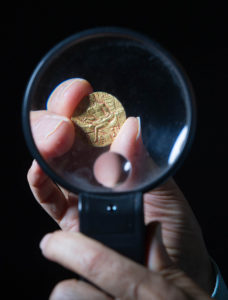
Here is how a several centuries-old coin may rewrite a key chapter in the history of ancient India: In 1851, a hoard of gold coins issued by kings from the Gupta dynasty was unearthed near the holy city of Varanasi, in northern India. The Guptas, who ruled from the 4th to 6th centuries AD, had ushered in the “Golden Age” of ancient India, a blossoming of the arts and sciences that produced the concept of zero, a heliocentric astronomy, and the Kama Sutra.
Gupta kings stamped their given names on the front of their coins and, on the back, an assumed name ending in “aditya,” or sun. On two of the coins in the hoard, scholars were able to read only the king’s assumed name—Prakasaditya, or splendor of the sun—but it seemed obvious that these, too, were Gupta coins. Few scholars disagreed. Without the given name, however, the mystery would remain for more than 160 years: Which Gupta king was Prakasaditya? When did he rule?
Read the rest here. html.